E-Triage Systems for COVID-19 Outbreak: Review and Recommendations
Abstract
:1. Introduction
2. Literature Review
2.1. ED General Triage Systems
2.2. ED Triage Systems for COVID-19
2.2.1. Worldwide Triage Systems
2.2.2. Saudi Arabia’s Triage System
2.2.3. Symptoms of COVID-19 and Patient Classifications
3. Evaluation and Discussion
3.1. Waiting Time
3.2. Simplicity
3.3. Reliability and Validity
3.4. Scalability and Adaptability
- The majority of triage operations should be conducted by an automated system to minimize the rate of error and time spent by the triage nurse using conventional approaches. Table 2 shows that the majority of the suggested solutions automate the triage processes.
- Not all patients who come to the EDs are required to be admitted to these departments. Early classification of patients’ severity status will aid in reducing ED congestion, particularly in times where infectious diseases such as COVID-19 is spreading. Therefore, we recommend that the triage system be linked to a remote diagnostic system such as the systems proposed in [44,87], through which the patient’s condition is evaluated to determine the severity level upon which he will be admitted to the ED or transferred to other care departments.
- New diseases may emerge that require specific patient triaging criteria, which may change over time. For example, the COVID-19 pandemic, which is an infectious disease that necessitates rapid classification, the WHO has had to develop a specific system to classify suspected COVID-19 cases. From Table 3 as well as the discussion in Section 2.2.3, we can note that symptom variety and changeability play a big role in classifying patients. Therefore, we recommend that the system be flexible, scalable, and adjustable so it can easily and quickly adapt to changing conditions.
3.5. Observations
4. Recommended Solutions
4.1. Electronic Triage System
- Since the COVID-19 pandemic case is not stable and many things arise while addressing the problem, there is a need for an adaptive system that allows resetting its parameters in a flexible and quick way.
- To reduce overcrowding in Eds, which results in the possible reduction of infection spreading, we recommend that the system provide a mechanism to receive patients’ requests remotely instead of personally coming to the ED.
- The system should have an expert model and decision support layer that guides the hospital in filtering requests and managing patient waiting time.
4.2. Electronic Medical Record
4.3. Medical Sensors Devices
4.4. Scoring System and Classification Criteria
4.4.1. Admission Criteria for COVID-19 Patients
- The first criterion is that if the patient requires invasive mechanical ventilation. To satisfy and determine this condition in our proposed system, it is required from the patient who is contacting the hospital through the mobile application to determine if they have a breathing problem. The ED needs to contact the patient and conduct a quick interview to ensure the existence of such condition. Considering the available resources, this condition is enough to accept a patient regardless of the other symptoms whether they are related or not to COVID-19.
- The second criterion is that if the patient requires NIV for more than two hours or HFNC. To ensure accuracy when determining such a condition, the ED can call and ask more questions to determine if the patient is in need for such treatments. Therefore, criterion 1 and 2 need the intervention of a specialist from the ED department to make a final decision on the case.
4.4.2. COVID-19 Severity Level-Based Criteria
5. Conclusions and Future Work
Author Contributions
Funding
Institutional Review Board Statement
Informed Consent Statement
Data Availability Statement
Acknowledgments
Conflicts of Interest
References
- Chavez, S.; Long, B.; Koyfman, A.; Liang, S.Y. Coronavirus Disease (COVID-19): A primer for emergency physicians. Am. J. Emerg. Med. 2020. [Google Scholar] [CrossRef]
- White, D.B.; Lo, B. Mitigating Inequities and Saving Lives with ICU Triage during the COVID-19 Pandemic. Am. J. Respir. Crit. Care Med. 2021, 203, 287–295. [Google Scholar] [CrossRef]
- Adiga, A.; Dubhashi, D.; Lewis, B.; Marathe, M.; Venkatramanan, S.; Vullikanti, A. Mathematical Models for COVID-19 Pandemic: A Comparative Analysis. J. Indian Inst. Sci. 2020, 100, 793–807. [Google Scholar] [CrossRef]
- Morley, C.; Unwin, M.; Peterson, G.M.; Stankovich, J.; Kinsman, L. Emergency department crowding: A systematic review of causes, consequences and solutions. PLoS ONE 2018, 13, e0203316. [Google Scholar] [CrossRef] [PubMed]
- Lee, I.-K.; Wang, C.-C.; Lin, M.-C.; Kung, C.-T.; Lan, K.-C.; Lee, C.-T. Effective strategies to prevent coronavirus disease-2019 (COVID-19) outbreak in hospital. J. Hosp. Infect. 2020, 105, 102–103. [Google Scholar] [CrossRef] [Green Version]
- Iacobucci, G. Covid-19: Emergency departments lack proper isolation facilities, senior medic warns. BMJ 2020, 368, m953. [Google Scholar] [CrossRef] [PubMed] [Green Version]
- Wang, Z.; Tang, K. Combating COVID-19: Health equity matters. Nat. Med. 2020, 26, 458. [Google Scholar] [CrossRef] [PubMed]
- Afilal, M.; Yalaoui, F.; Dugardin, F.; Amodeo, L.; Laplanche, D.; Blua, P. Forecasting the Emergency Department Patients Flow. J. Med. Syst. 2016, 40, 175. [Google Scholar] [CrossRef]
- Carmen, R.; Van Nieuwenhuyse, I.; Van Houdt, B. Inpatient boarding in emergency departments: Impact on patient delays and system capacity. Eur. J. Oper. Res. 2018, 271, 953–967. [Google Scholar] [CrossRef]
- Aboagye-Sarfo, P.; Mai, Q.; Sanfilippo, F.M.; Fatovich, D.M. Impact of population ageing on growing demand for emergency transportation to emergency departments in Western Australia, 2005–2020. Emerg. Med. Australas 2016, 28, 551–557. [Google Scholar] [CrossRef]
- Laudicella, M.; Martin, S.; Donni, P.L.; Smith, P.C. Do Reduced Hospital Mortality Rates Lead to Increased Utilization of Inpatient Emergency Care? A Population-Based Cohort Study. Health Serv. Res. 2017, 53, 2324–2345. [Google Scholar] [CrossRef] [PubMed]
- How Long Is Too Long to Wait in the Emergency Department? Southeastern Med Hospital—Cambridge Ohio. Available online: http://www.seormc.org/blog-archive/369-how-long-is-too-long-to-wait-in-the-emergency-department.html (accessed on 1 June 2020).
- Afilal, M.; Amodeo, L.; Yalaoui, F.; Dugardin, F. Forecasting Patient Flows into Emergency Services. In Hospital Logistics and e-Management; Wiley: Hoboken, NJ, USA, 2019; pp. 85–143. [Google Scholar]
- Jones, S.S.; Thomas, A.; Evans, R.S.; Welch, S.J.; Haug, P.J.; Snow, G.L. Forecasting Daily Patient Volumes in the Emergency Department. Acad. Emerg. Med. 2008, 15, 159–170. [Google Scholar] [CrossRef]
- Bashshur, R.; Doarn, C.R.; Frenk, J.M.; Kvedar, J.C.; Woolliscroft, J.O. Telemedicine and the COVID-19 Pandemic, Lessons for the Future. Telemed. e-Health 2020, 26, 571–573. [Google Scholar] [CrossRef] [PubMed] [Green Version]
- Gadzinski, A.J.; Gore, J.L.; Ellimoottil, C.; Odisho, A.Y.; Watts, K.L. Implementing Telemedicine in Response to the COVID-19 Pandemic. J. Urol. 2020, 204, 14–16. [Google Scholar] [CrossRef] [PubMed] [Green Version]
- Portnoy, J.; Waller, M.; Elliott, T. Telemedicine in the Era of COVID-19. J. Allergy Clin. Immunol. Pr. 2020, 8, 1489–1491. [Google Scholar] [CrossRef]
- Mihalj, M.; Carrel, T.; Gregoric, I.D.; Andereggen, L.; Zinn, P.O.; Doll, D.; Stueber, F.; Gabriel, R.A.; Urman, R.D.; Luedi, M.M. Telemedicine for preoperative assessment during a COVID-19 pandemic: Recommendations for clinical care. Best Pr. Res. Clin. Anaesthesiol. 2020, 34, 345–351. [Google Scholar] [CrossRef]
- Endler, M.; Lavelanet, A.; Cleeve, A.; Ganatra, B.; Gomperts, R.; Gemzell-Danielsson, K. Telemedicine for medical abortion: A systematic review. BJOG Int. J. Obstet. Gynaecol. 2019, 126, 1094–1102. [Google Scholar] [CrossRef]
- Lupton, D.; Maslen, S. Telemedicine and the senses: A review. Sociol. Health Illn. 2017, 39, 1557–1571. [Google Scholar] [CrossRef]
- Romanick-Schmiedl, S.; Raghu, G. Telemedicine—Maintaining quality during times of transition. Nat. Rev. Dis. Prim. 2020, 6, 1–2. [Google Scholar] [CrossRef]
- Ahir, S.; Telavane, D.; Thomas, R. The impact of Artificial Intelligence, Blockchain, Big Data and evolving technologies in Coronavirus Disease-2019 (COVID-19) curtailment. In Proceedings of the 2020 International Conference on Smart Electronics and Communication (ICOSEC), Trichy, Tamilnadu, 10–12 September 2020; Volume 2019, pp. 113–120. [Google Scholar]
- Celesti, A.; Ruggeri, A.; Fazio, M.; Galletta, A.; Villari, M.; Romano, A. Blockchain-Based Healthcare Workflow for Tele-Medical Laboratory in Federated Hospital IoT Clouds. Sensors 2020, 20, 2590. [Google Scholar] [CrossRef]
- La Gatta, V.; Moscato, V.; Postiglione, M.; Sperli, G. An Epidemiological Neural Network Exploiting Dynamic Graph Structured Data Applied to the COVID-19 Outbreak. IEEE Trans. Big Data 2021, 7, 45–55. [Google Scholar] [CrossRef]
- Khan, F.; Ghaffar, A.; Khan, N.; Cho, S.H. An Overview of Signal Processing Techniques for Remote Health Monitoring Using Impulse Radio UWB Transceiver. Sensors 2020, 20, 2479. [Google Scholar] [CrossRef] [PubMed]
- Moraes, M.; Mendes, T.; Arantes, R. Smart Wearables for Cardiac Autonomic Monitoring in Isolated, Confined and Extreme Environments: A Perspective from Field Research in Antarctica. Sensors 2021, 21, 1303. [Google Scholar] [CrossRef] [PubMed]
- Rath, M. Big Data and IoT-Allied Challenges Associated with Healthcare Applications in Smart and Automated Systems. Data Anal. Med. 2020, 1401–1414. [Google Scholar] [CrossRef]
- Rathore, M.M.; Ahmad, A.; Paul, A.; Wan, J.; Zhang, D. Real-time Medical Emergency Response System: Exploiting IoT and Big Data for Public Health. J. Med. Syst. 2016, 40, 283. [Google Scholar] [CrossRef]
- Saheb, T.; Izadi, L. Paradigm of IoT big data analytics in the healthcare industry: A review of scientific literature and mapping of research trends. Telemat. Inform. 2019, 41, 70–85. [Google Scholar] [CrossRef]
- Talal, M.; Zaidan, A.A.; Zaidan, B.B.; Albahri, A.S.; Alamoodi, A.H.; AlSalem, M.A.; Lim, C.K.; Tan, K.L.; Shir, W.L.; Mohammed, K.I. Smart Home-based IoT for Real-time and Secure Remote Health Monitoring of Triage and Priority System using Body Sensors: Multi-driven Systematic Review. J. Med. Syst. 2019, 43, 42. [Google Scholar] [CrossRef]
- Rathore, M.M.; Paul, A.; Hong, W.-H.; Seo, H.; Awan, I.; Saeed, S. Exploiting IoT and big data analytics: Defining Smart Digital City using real-time urban data. Sustain. Cities Soc. 2018, 40, 600–610. [Google Scholar] [CrossRef]
- Dash, S.P. The Impact of IoT in Healthcare: Global Technological Change & The Roadmap to a Networked Architecture in India. J. Indian Inst. Sci. 2020, 100, 773–785. [Google Scholar] [CrossRef]
- Mishra, K.N.; Chakraborty, C. A Novel Approach Towards Using Big Data and IoT for Improving the Efficiency of m-Health Systems. Recent Adv. Comput. Optim. 2019, 875, 123–139. [Google Scholar] [CrossRef]
- Bu, X.; Lu, L.; Zhang, Z.; Zhang, Q.; Zhu, Y. A General Outpatient Triage System Based on Dynamic Uncertain Causality Graph. IEEE Access 2020, 8, 93249–93263. [Google Scholar] [CrossRef]
- Hinson, J.S.; Martinez, D.A.; Cabral, S.; George, K.; Whalen, M.; Hansoti, B.; Levin, S. Triage Performance in Emergency Medicine: A Systematic Review. Ann. Emerg. Med. 2019, 74, 140–152. [Google Scholar] [CrossRef]
- Considine, J.; Levasseur, S.A.; Villanueva, E. The Australasian Triage Scale: Examining emergency department nurses’ performance using computer and paper scenarios. Ann. Emerg. Med. 2004, 44, 516–523. [Google Scholar] [CrossRef]
- Hodge, A.; Hugman, A.; Varndell, W.; Howes, K. A review of the quality assurance processes for the Australasian Triage Scale (ATS) and implications for future practice. Australas Emerg. Nurs. J. 2013, 16, 21–29. [Google Scholar] [CrossRef] [Green Version]
- Kiblboeck, D.; Steinrueck, K.; Nitsche, C.; Lang, W.; Kellermair, J.; Blessberger, H.; Steinwender, C.; Siostrzonek, P. Evaluation of the Manchester triage system for patients with acute coronary syndrome. Wien. Klin. Wochenschr. 2020, 132, 277–282. [Google Scholar] [CrossRef] [Green Version]
- Canadian Ministry of Health and Long-Term Care Prehospital Canadian Triage Acuity Scale: Prehospital CTAS Paramedic Guide. Ontario Hospital Association. 2016, Volume 2. Available online: http://www.ontariobasehospitalgroup.ca/Provincial-Standards/Downloads_GetFile.aspx?id=18042 (accessed on 1 June 2020).
- Bullard, M.J.; Musgrave, E.; Warren, D.; Unger, B.; Skeldon, T.; Grierson, R.; van der Linde, E.; Swain, J. Revisions to the Canadian Emergency Department Triage and Acuity Scale (CTAS) Guidelines. CJEM 2017, 19, S18–S27. [Google Scholar] [CrossRef] [PubMed] [Green Version]
- Paediatric Triage Working Group (PTWG) of the Western Cape Government the South African Triage Scale Training Manual. 2012. Available online: https://emssa.org.za/wp-content/uploads/2011/04/SATS-Manual-A5-LR-spreads.pdf (accessed on 27 March 2021).
- Qureshi, N. Triage systems: A review of the literature with reference to Saudi Arabia. East. Mediterr. Health J. 2010, 16, 690–698. [Google Scholar] [CrossRef] [PubMed]
- Al-Fayyadh, F.M.; Bin Saeed, A.; Alshomar, K.M.; Zekry, Z.W.; AlAmiri, N.N.; Abaalkhail, A.M.; Aldughaither, A.A.; Alaska, Y.A. Validating the implementation of the triage system in an emergency department in a University Hospital. J. Health Spéc. 2017, 5, 73. [Google Scholar] [CrossRef]
- Salman, O.H.; Rasid, M.F.A.; Saripan, M.I.; Subramaniam, S.K. Multi-Sources Data Fusion Framework for Remote Triage Prioritization in Telehealth. J. Med. Syst. 2014, 38, 1–23. [Google Scholar] [CrossRef]
- Ashour, O.M.; Kremer, G.E.O. Dynamic patient grouping and prioritization: A new approach to emergency department flow improvement. Health Care Manag. Sci. 2014, 19, 192–205. [Google Scholar] [CrossRef]
- Golgoun, A.S.; Sepidnam, G. The optimized algorithm for prioritizing and scheduling of patient appointment at a health center according to the highest rating in waiting Queue. Int. J. Sci. Technol. Res. 2018, 7, 240–245. [Google Scholar]
- Lima, B.; Faria, J.P. Towards Real-Time Patient Prioritization in Hospital Emergency Services. In Proceedings of the 2018 IEEE 20th International Conference on e-Health Networking, Applications and Services (Healthcom), Ostrava, Czech Republic, 17–20 September 2018; pp. 1–4. [Google Scholar]
- Lin, D.; Patrick, J.; LaBeau, F. Estimating the waiting time of multi-priority emergency patients with downstream blocking. Health Care Manag. Sci. 2014, 17, 88–99. [Google Scholar] [CrossRef] [PubMed] [Green Version]
- Ding, Y.; Park, E.; Nagarajan, M.; Grafstein, E. Patient Prioritization in Emergency Department Triage Systems: An Empirical Study of the Canadian Triage and Acuity Scale (CTAS). Manuf. Serv. Oper. Manag. 2019, 21, 723–741. [Google Scholar] [CrossRef]
- Kumar, A.; Lakshminarayanan, D.; Joshi, N.; Vaid, S.; Bhoi, S.; Deorari, A. Triaging the triage: Reducing waiting time to triage in the emergency department at a tertiary care hospital in New Delhi, India. Emerg. Med. J. 2019, 36, 558–563. [Google Scholar] [CrossRef] [PubMed] [Green Version]
- Hou, J.; Zhao, X. Using a priority queuing approach to improve emergency department performance. J. Manag. Anal. 2019, 7, 28–43. [Google Scholar] [CrossRef]
- Wallace, D.W.; Burleson, S.L.; Heimann, M.A.; Crosby, J.C.; Swanson, J.; Gibson, C.B.; Greene, C. An adapted emergency department triage algorithm for the COVID-19 pandemic. J. Am. Coll. Emerg. Physicians Open 2020, 1, 1374–1379. [Google Scholar] [CrossRef]
- Wang, D.; Hu, B.; Hu, C.; Zhu, F.; Liu, X.; Zhang, J.; Wang, B.; Xiang, H.; Cheng, Z.; Xiong, Y.; et al. Clinical Characteristics of 138 Hospitalized Patients With 2019 Novel Coronavirus–Infected Pneumonia in Wuhan, China. JAMA 2020, 323, 1061–1069. [Google Scholar] [CrossRef] [PubMed]
- Tao, J.; Song, Z.; Yang, L.; Huang, C.; Feng, A.; Man, X. Emergency management for preventing and controlling nosocomial infection of the 2019 novel coronavirus: Implications for the dermatology department. Br. J. Dermatol. 2020, 182, 1477–1478. [Google Scholar] [CrossRef] [PubMed] [Green Version]
- Corden, E.; Rogers, A.K.; Woo, W.A.; Simmonds, R.; Mitchell, C.D. A targeted response to the COVID-19 pandemic: Analysing effectiveness of remote consultations for triage and management of routine dermatology referrals. Clin. Exp. Dermatol. 2020, 45, 1047–1050. [Google Scholar] [CrossRef]
- Paleri, V.; Hardman, J.; Tikka, T.; Bradley, P.; Pracy, P.; Kerawala, C. Rapid implementation of an evidence-based remote triaging system for assessment of suspected referrals and patients with head and neck cancer on follow-up after treatment during the COVID -19 pandemic: Model for international collaboration. Head Neck 2020, 42, 1674–1680. [Google Scholar] [CrossRef]
- Kassardjian, C.D.; Desai, U.; Narayanaswami, P. The AANEM Quality and Patient Safety Committee of the AANEM Practical guidance for managing electromyography requests and testing during the COVID -19 pandemic. Muscle Nerve 2020, 62, 30–33. [Google Scholar] [CrossRef] [PubMed] [Green Version]
- Shah, P.B.; Welt, F.G.P.; Mahmud, E.; Phillips, A.; Kleiman, N.S.; Young, M.N.; Sherwood, M.; Batchelor, W.; Wang, D.D.; Davidson, L.; et al. Triage considerations for patients referred for structural heart disease intervention during the COVID -19 pandemic: An ACC/SCAI position statement. Catheter. Cardiovasc. Interv. 2020, 96, 659–663. [Google Scholar] [CrossRef] [PubMed] [Green Version]
- Lopez, J.J.; Ebinger, J.E.; Allen, S.; Yildiz, M.; Henry, T.D. Adapting STEMI care for the COVID -19 pandemic: The case for low-risk STEMI triage and early discharge. Catheter. Cardiovasc. Interv. 2020. [Google Scholar] [CrossRef] [PubMed]
- CDC Standard Operating Procedure (SOP) for Triage of Suspected COVID-19 Patients in non-US Healthcare Settings: Early Identi cation and Prevention of Transmission during Triage. Available online: https://www.cdc.gov/coronavirus/2019-ncov/hcp/non-us-settings/sop-triage-prevent-transmission.html (accessed on 1 June 2020).
- Dadashzadeh, A.; Alamdari, N.G.; Ala, A.; Dehghannejad, J.; Jabbarzadeh, F.; Babaie, N. Triage guidelines for emergency department patients with COVID-19. J. Res. Clin. Med. 2020, 8, 12. [Google Scholar] [CrossRef]
- Zhang, N.; Deng, Y.; Li, W.; Liu, J.; Li, H.; Liu, E.; Zheng, X. Analysis and suggestions for the preview and triage screening of children with suspected COVID-19 outside the epidemic area of Hubei Province. Transl. Pediatr. 2020, 9, 126–132. [Google Scholar] [CrossRef]
- Saudi Ministry of Health (MOH). Hospital Admission Criteria for COVID-19 Pediatric Patients, Version 1.1. Available online: https://www.moh.gov.sa/Ministry/MediaCenter/Publications/Documents/Hospital-admission-criteria.pdf (accessed on 12 December 2020).
- Weqaya (SaudiCDC) Coronavirus Disease COVID-19 Guidelines, v1.3. Available online: https://www.moh.gov.sa/Ministry/MediaCenter/Publications/Documents/Coronavirus-Disease-2019-Guidelines-v1.2.pdf (accessed on 20 November 2020).
- Saudi Ministry of Health (MOH) ICU Triage, Admission, and Discharge Criteria during the COVID 19 Pandemic. Available online: https://www.moh.gov.sa/Ministry/MediaCenter/Publications/Documents/ICU-Criteria-during.pdf (accessed on 12 December 2020).
- Physiopedia-Contributors. Respiratory Management of COVID 19. Physiopedia. 2020. Available online: https://www.physio-pedia.com/Respiratory_Management_of_COVID_19 (accessed on 14 June 2020).
- Zu, Z.Y.; Di Jiang, M.; Xu, P.P.; Chen, W.; Ni, Q.Q.; Lu, G.M.; Zhang, L.J. Coronavirus Disease 2019 (COVID-19): A Perspective from China. Radiology 2020, 296, E15–E25. [Google Scholar] [CrossRef] [Green Version]
- General Office of National Health Committee. Office of State Administration of Traditional Chinese Medicine Notice on the Issuance of a New Coronavirus Infection Pneumonia Diagnosis and Treatmen Plan (Trial Fifth Version). Available online: http://bgs.satcm.gov.cn/zhengcewenjian/2020-02-06/12847.html (accessed on 27 June 2020).
- Spinato, G.; Fabbris, C.; Polesel, J.; Cazzador, D.; Borsetto, D.; Hopkins, C.; Boscolo-Rizzo, P. Alterations in Smell or Taste in Mildly Symptomatic Outpatients With SARS-CoV-2 Infection. JAMA 2020, 323, 2089–2090. [Google Scholar] [CrossRef] [Green Version]
- Feng, Y.; Ling, Y.; Bai, T.; Xie, Y.; Huang, J.; Li, J.; Xiong, W.; Yang, D.; Chen, R.; Lu, F.; et al. COVID-19 with Different Severities: A Multicenter Study of Clinical Features. Am. J. Respir. Crit. Care Med. 2020, 201, 1380–1388. [Google Scholar] [CrossRef]
- Zhao, X.; Zhang, B.; Li, P.; Ma, C.; Gu, J.; Hou, P.; Guo, Z.; Wu, H.; Bai, Y. Incidence, clinical characteristics and prognostic factor of patients with COVID-19: A systematic review and meta-analysis. medRxiv 2020. [Google Scholar] [CrossRef]
- Guan, W.J.; Ni, Z.Y.; Hu, Y.; Liang, W.H.; Ou, C.Q.; He, J.X.; Liu, L.; Shan, H.; Lei, C.L.; Hui, D.S.C.; et al. Clinical Characteristics of Coronavirus Disease 2019 in China. N. Engl. J. Med. 2020, 382, 1708–1720. [Google Scholar] [CrossRef]
- Chen, N.; Zhou, M.; Dong, X.; Qu, J.; Gong, F.; Han, Y.; Qiu, Y.; Wang, J.; Liu, Y.; Wei, Y.; et al. Epidemiological and clinical characteristics of 99 cases of 2019 novel coronavirus pneumonia in Wuhan, China: A descriptive study. Lancet 2020, 395, 507–513. [Google Scholar] [CrossRef] [Green Version]
- Xu, X.-W.; Wu, X.-X.; Jiang, X.-G.; Xu, K.-J.; Ying, L.-J.; Ma, C.-L.; Li, S.-B.; Wang, H.-Y.; Zhang, S.; Gao, H.-N.; et al. Clinical findings in a group of patients infected with the 2019 novel coronavirus (SARS-Cov-2) outside of Wuhan, China: Retrospective case series. BMJ 2020, 368, m606. [Google Scholar] [CrossRef] [PubMed] [Green Version]
- Pan, L.; Mu, M.; Yang, P.; Sun, Y.; Wang, R.; Yan, J.; Li, P.; Hu, B.; Wang, J.; Hu, C.; et al. Clinical Characteristics of COVID-19 Patients With Digestive Symptoms in Hubei, China: A Descriptive, Cross-Sectional, Multicenter Study. Am. J. Gastroenterol. 2020, 115, 766–773. [Google Scholar] [CrossRef]
- World Health Organization. Clinical Management of Severe Acute Respiratory Infection (SARI) when COVID-19 Disease Is Suspected—Interim Guidance; World Health Organization, 2020. License: CC BY-NC-SA 3.0 IGO. Available online: https://apps.who.int/iris/handle/10665/331446 (accessed on 14 June 2020).
- Check if You or Your Child has Coronavirus Symptoms. Available online: https://www.nhs.uk/conditions/coronavirus-covid-19/symptoms/ (accessed on 14 June 2020).
- Yan, C.H.; Faraji, F.; Bs, D.P.P.; Boone, C.E.; DeConde, A.S. Association of chemosensory dysfunction and COVID-19 in patients presenting with influenza-like symptoms. Int. Forum Allergy Rhinol. 2020, 10, 806–813. [Google Scholar] [CrossRef] [Green Version]
- Tudrej, B.; Sebo, P.; Lourdaux, J.; Cuzin, C.; Floquet, M.; Haller, D.M.; Maisonneuve, H. Self-Reported Loss of Smell and Taste in SARS-CoV-2 Patients: Primary Care Data to Guide Future Early Detection Strategies. J. Gen. Intern. Med. 2020, 35, 2502–2504. [Google Scholar] [CrossRef]
- Giacomelli, A.; Pezzati, L.; Conti, F.; Bernacchia, D.; Siano, M.; Oreni, L.; Rusconi, S.; Gervasoni, C.; Ridolfo, A.L.; Rizzardini, G.; et al. Self-reported Olfactory and Taste Disorders in Patients With Severe Acute Respiratory Coronavirus 2 Infection: A Cross-sectional Study. Clin. Infect. Dis. 2020, 71, 889–890. [Google Scholar] [CrossRef] [Green Version]
- Yan, C.H.; Faraji, F.; Bs, D.P.P.; Ostrander, B.T.; DeConde, A.S. Self-reported olfactory loss associates with outpatient clinical course in COVID-19. Int. Forum Allergy Rhinol. 2020, 10, 821–831. [Google Scholar] [CrossRef] [Green Version]
- Wollina, U.; Karadağ, A.S.; Rowland-Payne, C.; Chiriac, A.; Lotti, T. Cutaneous signs in COVID-19 patients: A review. Dermatol. Ther. 2020, 33, e13549. [Google Scholar] [CrossRef] [PubMed]
- Zhang, J.; Zhou, L.; Yang, Y.; Peng, W.; Wang, W.; Chen, X. Therapeutic and triage strategies for 2019 novel coronavirus disease in fever clinics. Lancet Respir. Med. 2020, 8, e11–e12. [Google Scholar] [CrossRef] [Green Version]
- General Office of National Health Committee. Office of State Administration of Traditional Chinese Medicine Notice on the Issuance of a New Coronavirus Pneumonia Diagnosis and Treatment Plan (fo Trial Version 6). Available online: http://yzs.satcm.gov.cn/zhengcewenjian/2020-02-19/13221.html (accessed on 27 June 2020).
- World Health Organization. Home Care for Patients with Suspected Novel Coronavirus (nCoV) Infection Presenting with Mild Symptoms and Management of Contacts. 2020. License: CC BY-NC-SA 3.0 IGO. Available online: https://apps.who.int/iris/handle/10665/330671 (accessed on 14 June 2020).
- Elkum, N.B.; Barrett, C.; Al-Omran, H. Canadian Emergency DepartmentTriage and Acuity Scale: Implementation in a tertiary care center in Saudi Arabia. BMC Emerg. Med. 2011, 11, 3. [Google Scholar] [CrossRef] [PubMed] [Green Version]
- Almahdi, E.M.; Zaidan, A.A.; Zaidan, B.B.; AlSalem, M.A.; Albahri, O.S.; Albahri, A.S. Mobile-Based Patient Monitoring Systems: A Prioritisation Framework Using Multi-Criteria Decision-Making Techniques. J. Med. Syst. 2019, 43, 219. [Google Scholar] [CrossRef] [PubMed]
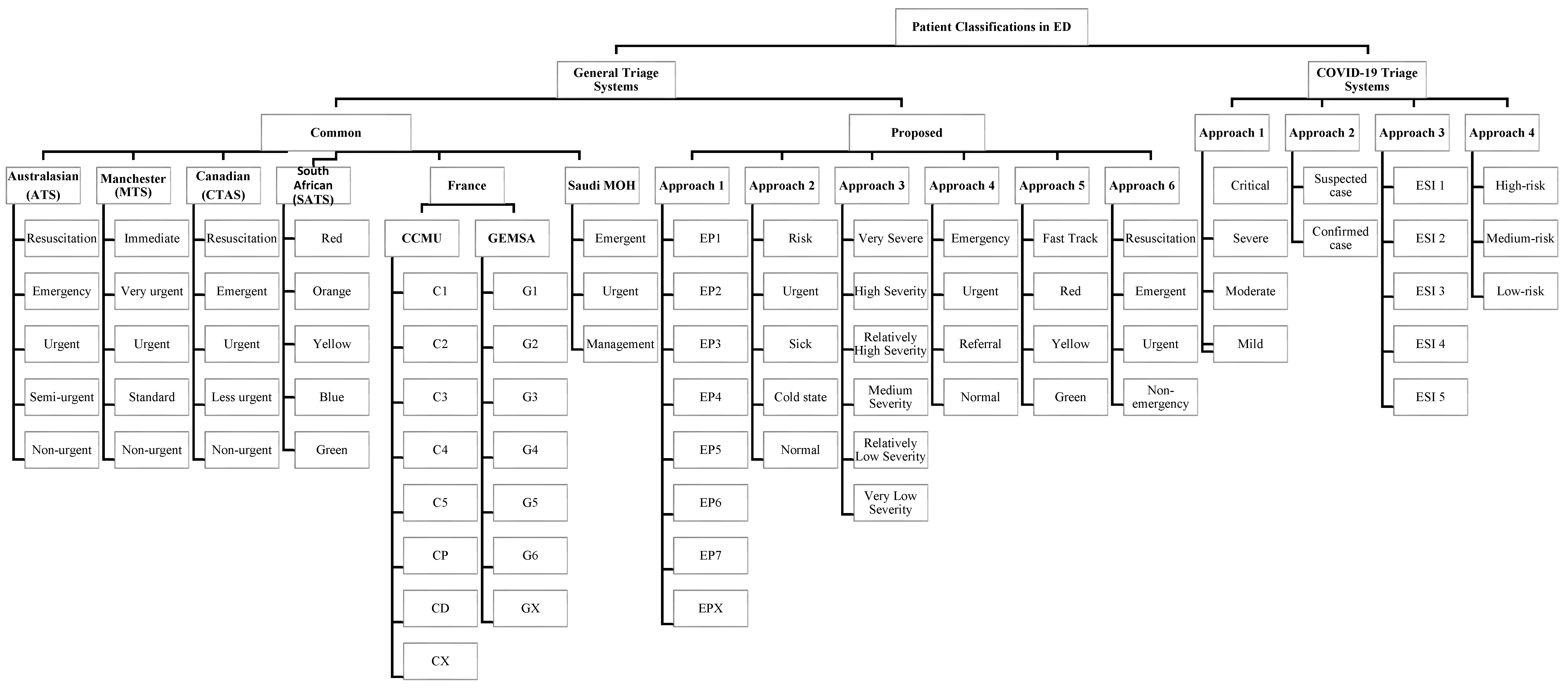
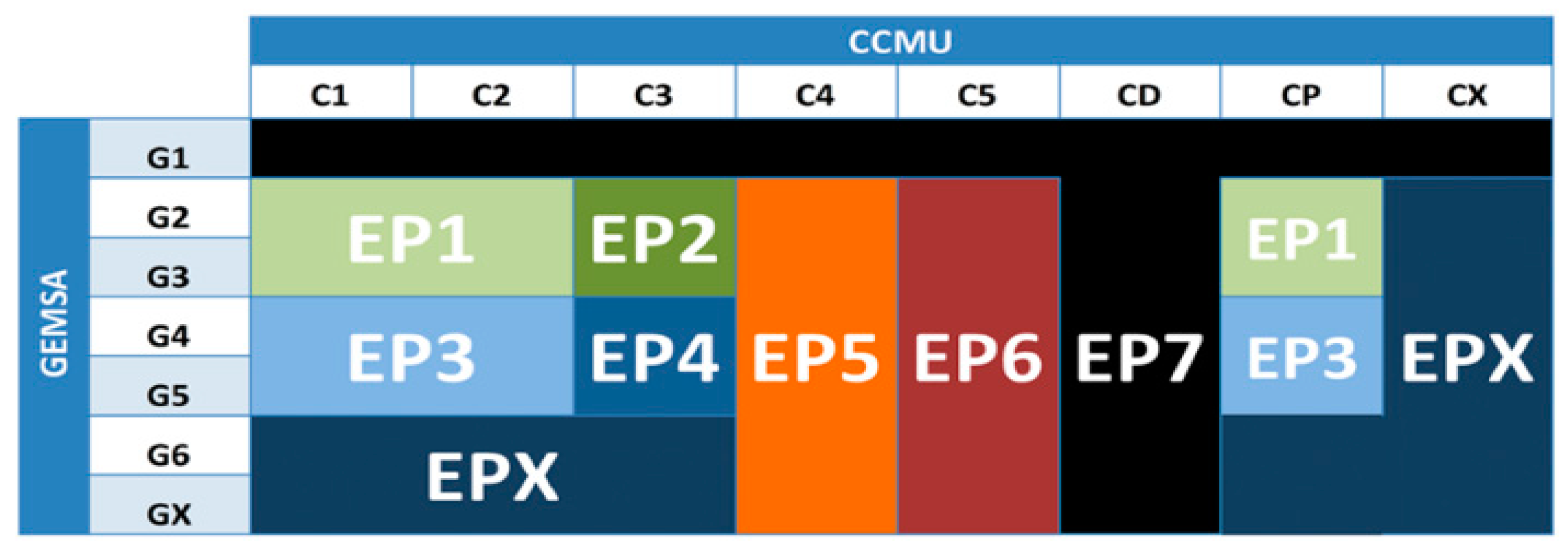
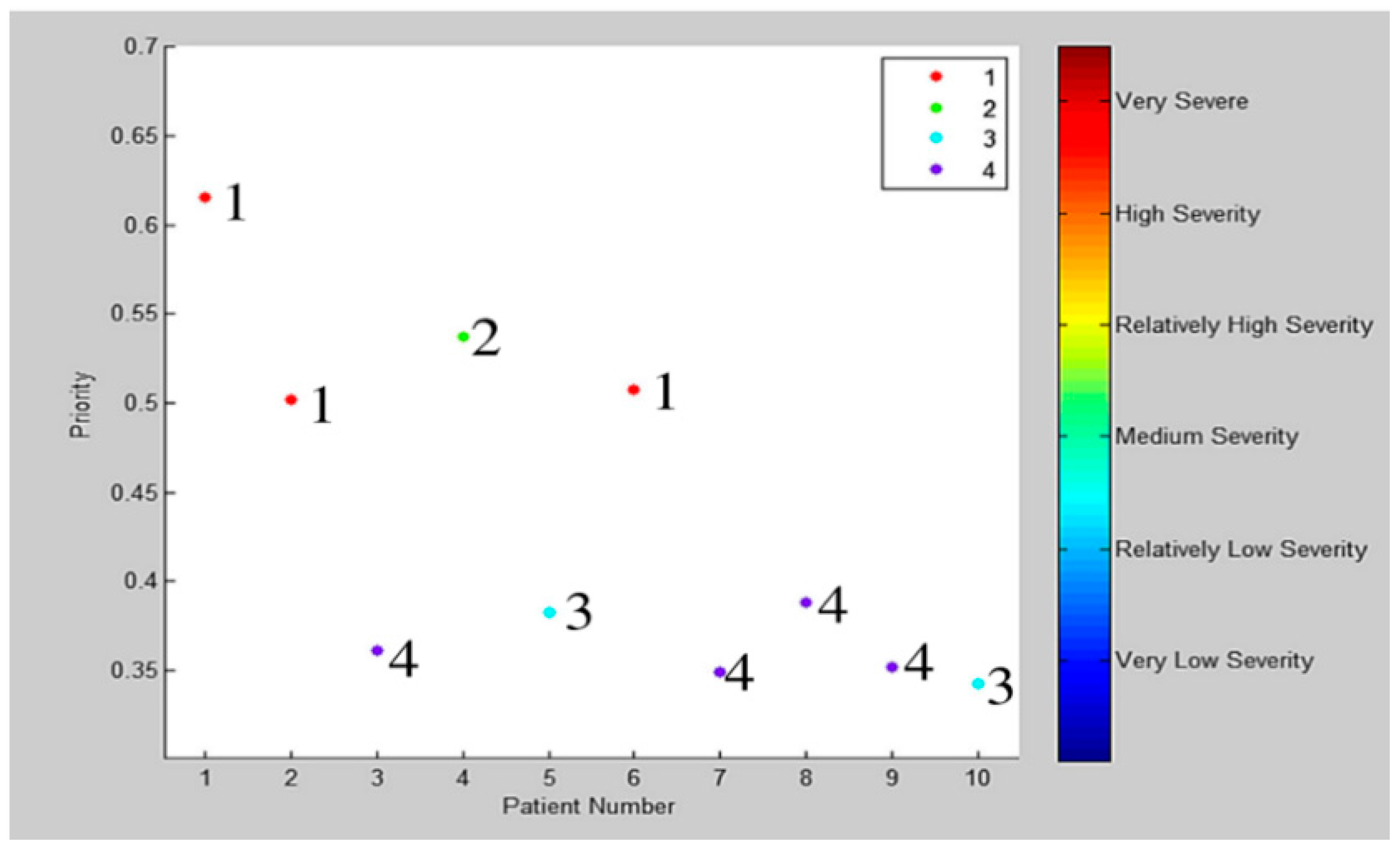

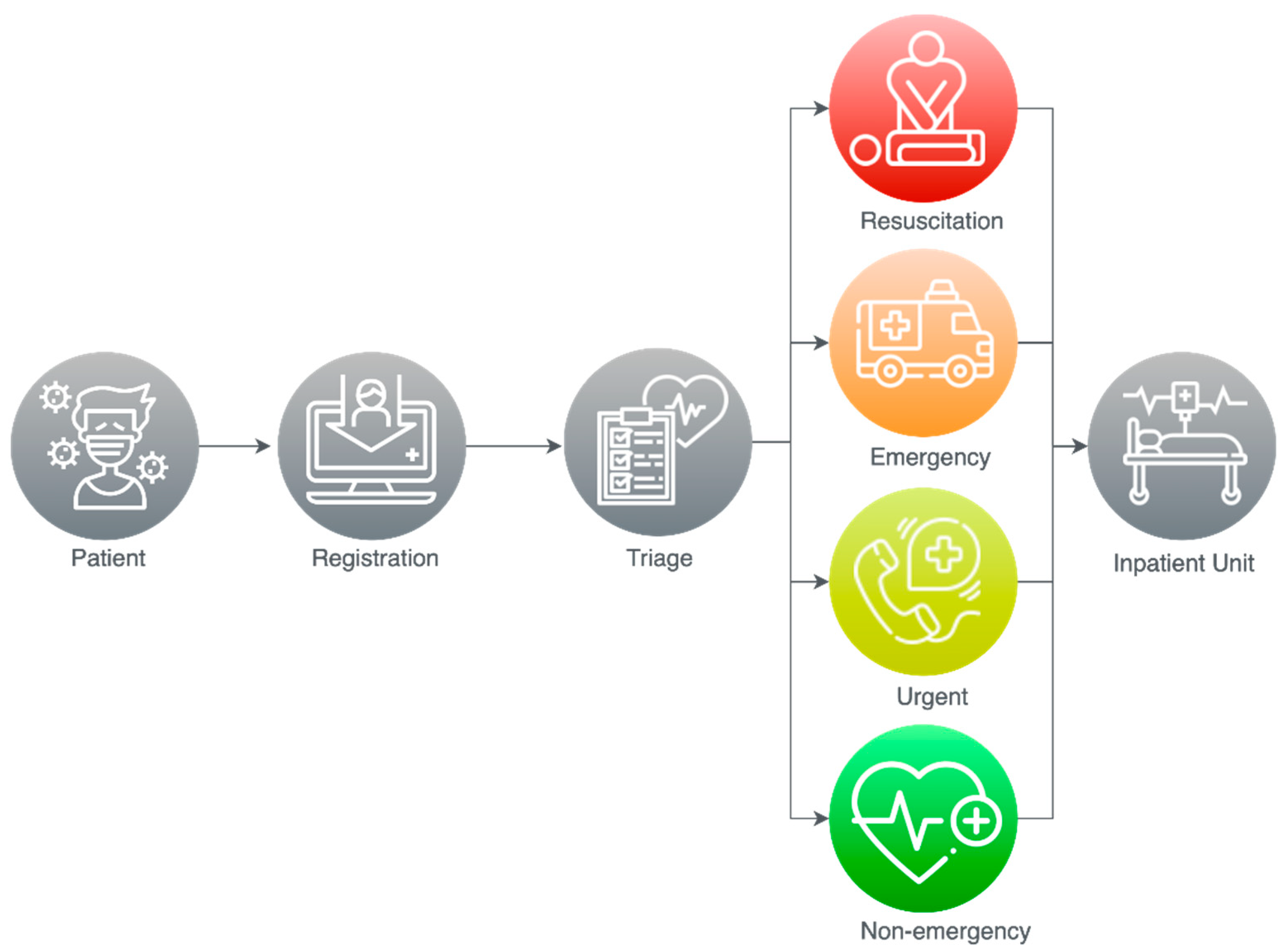
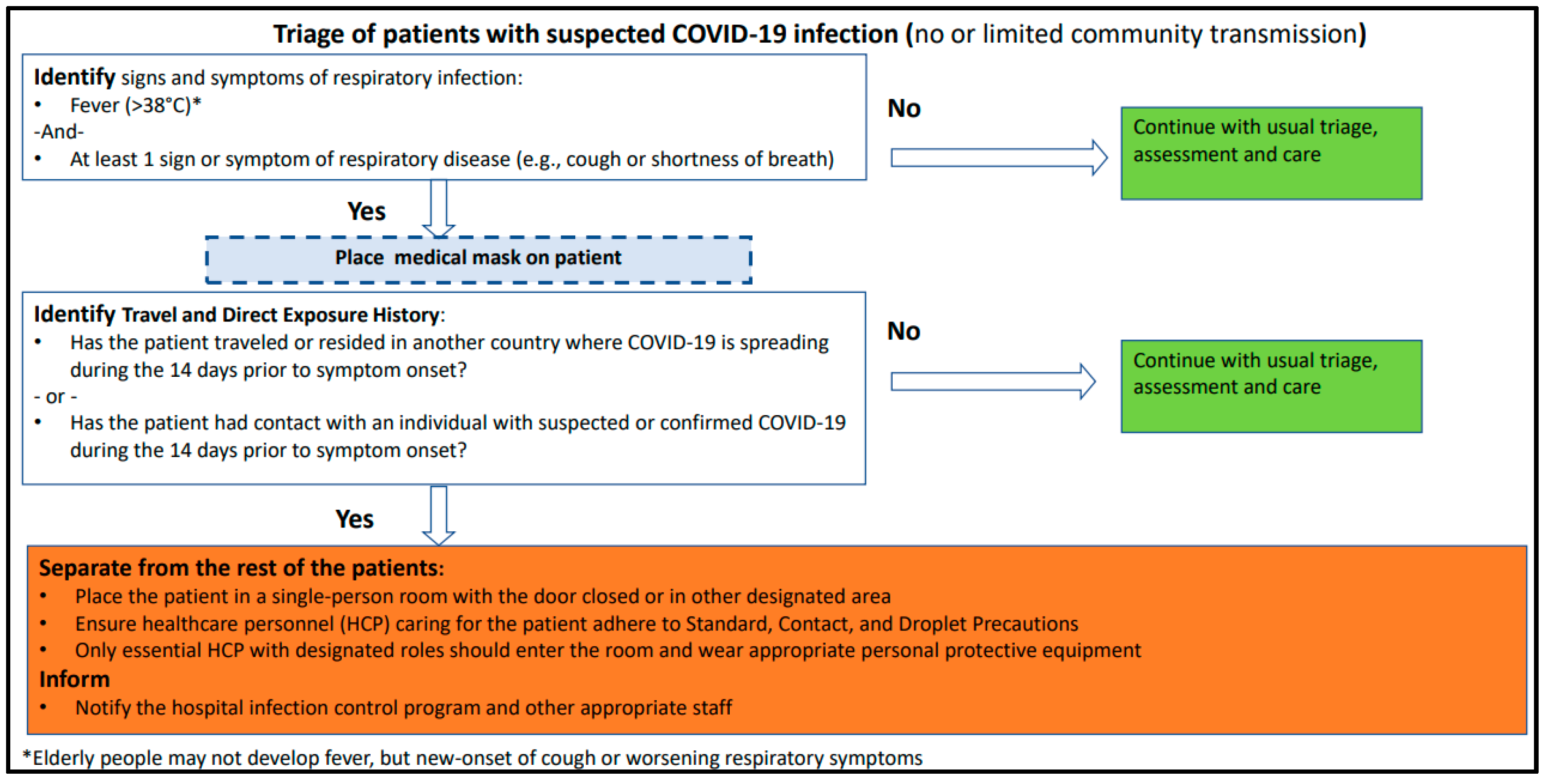
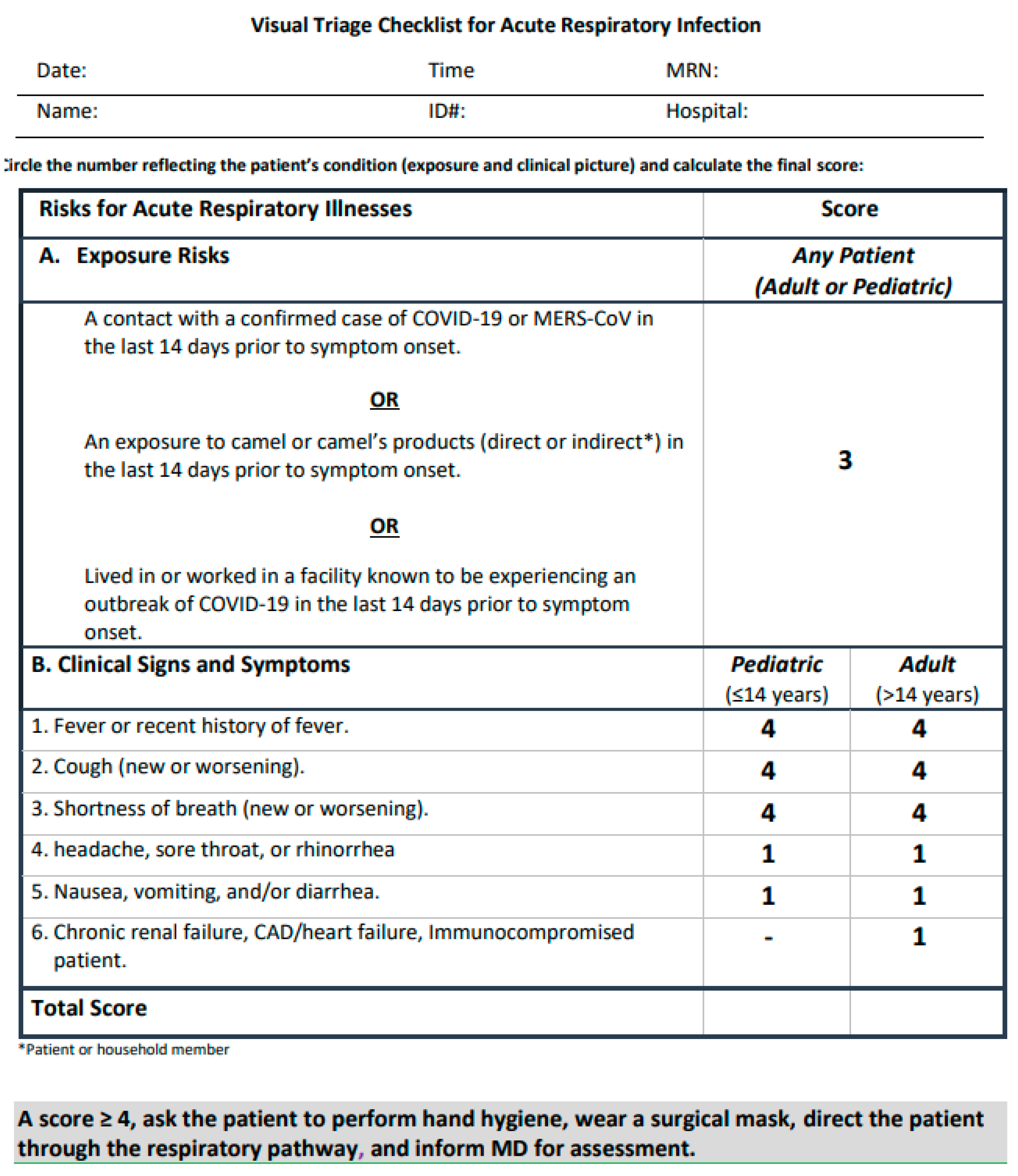
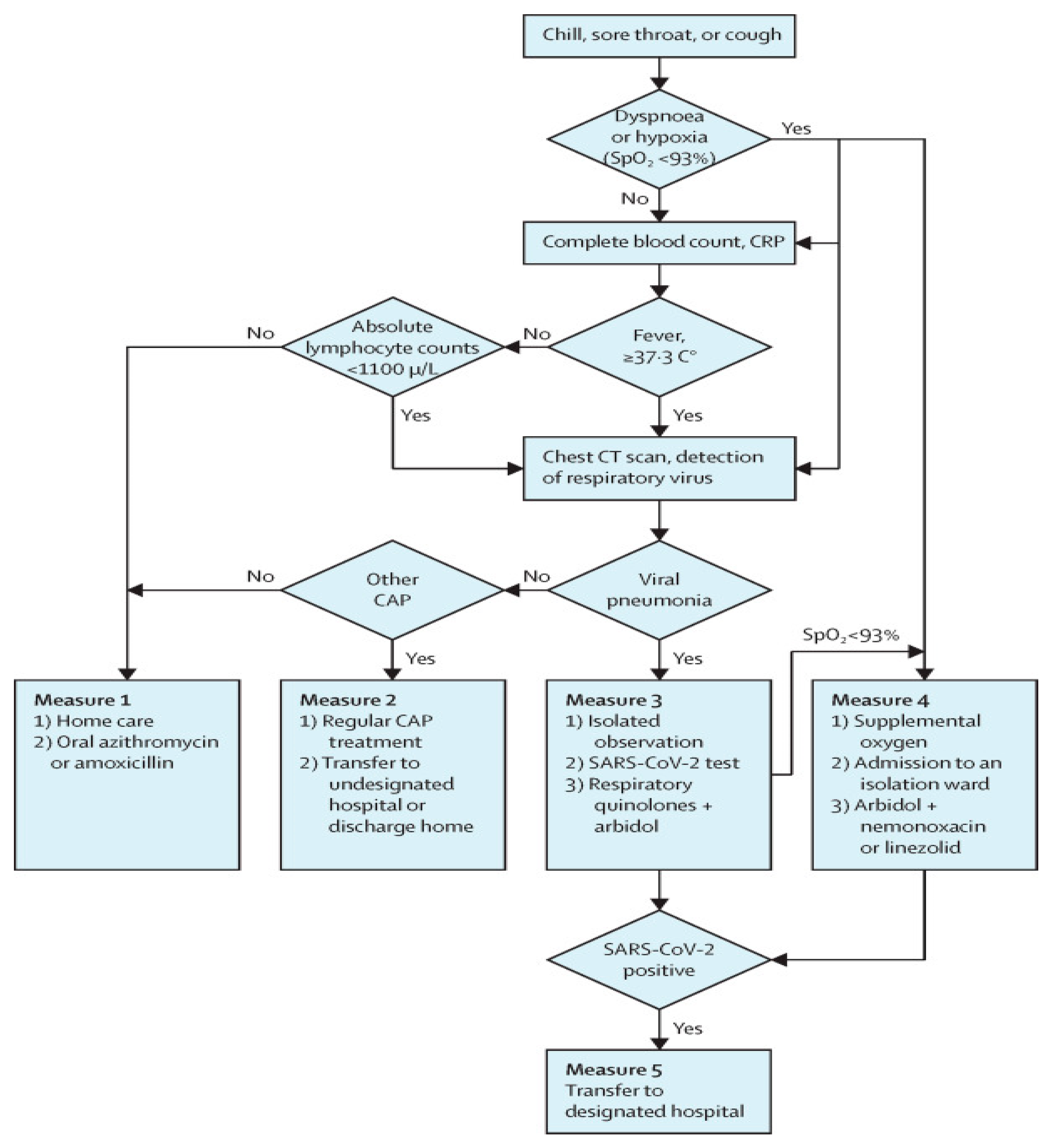
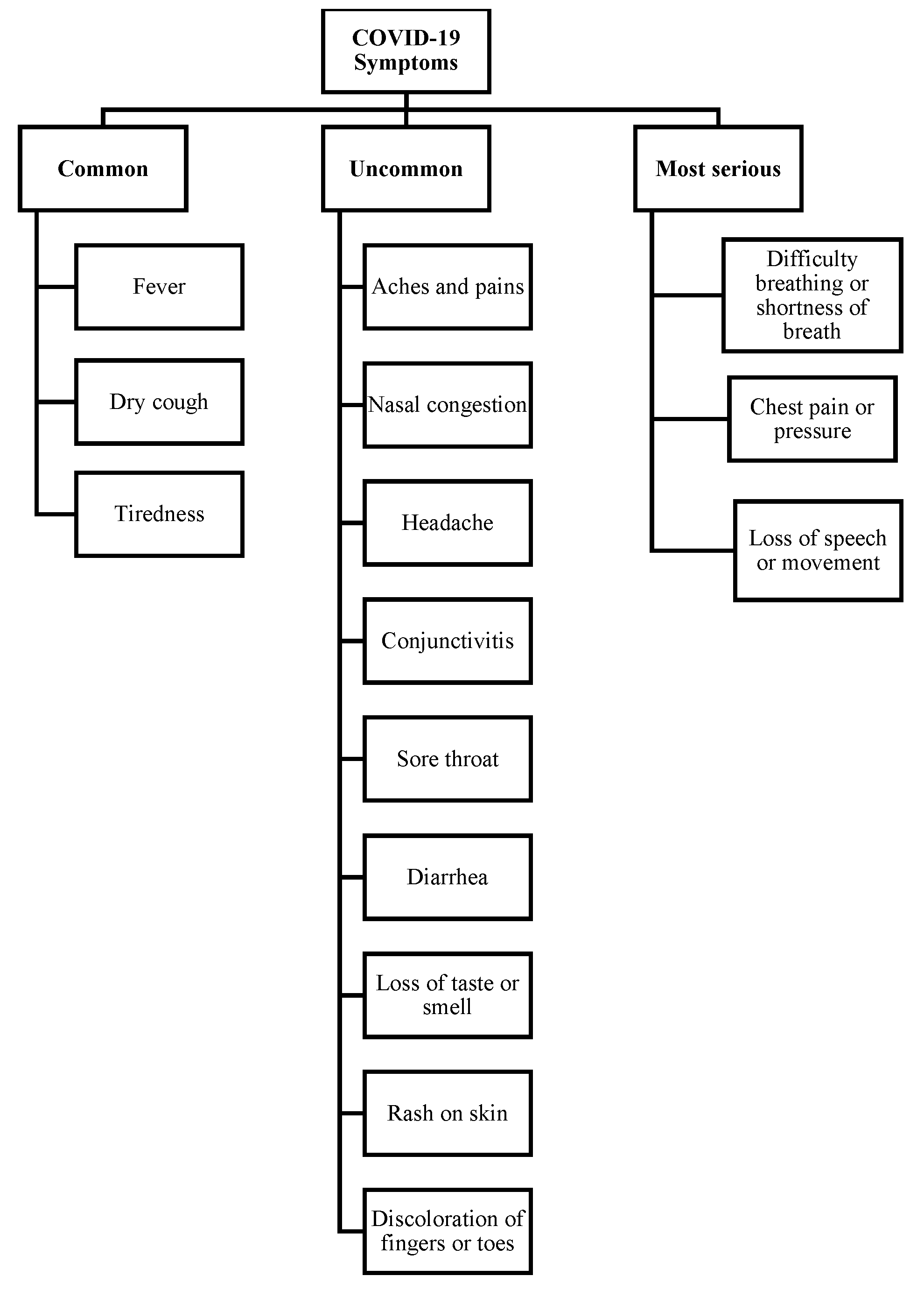
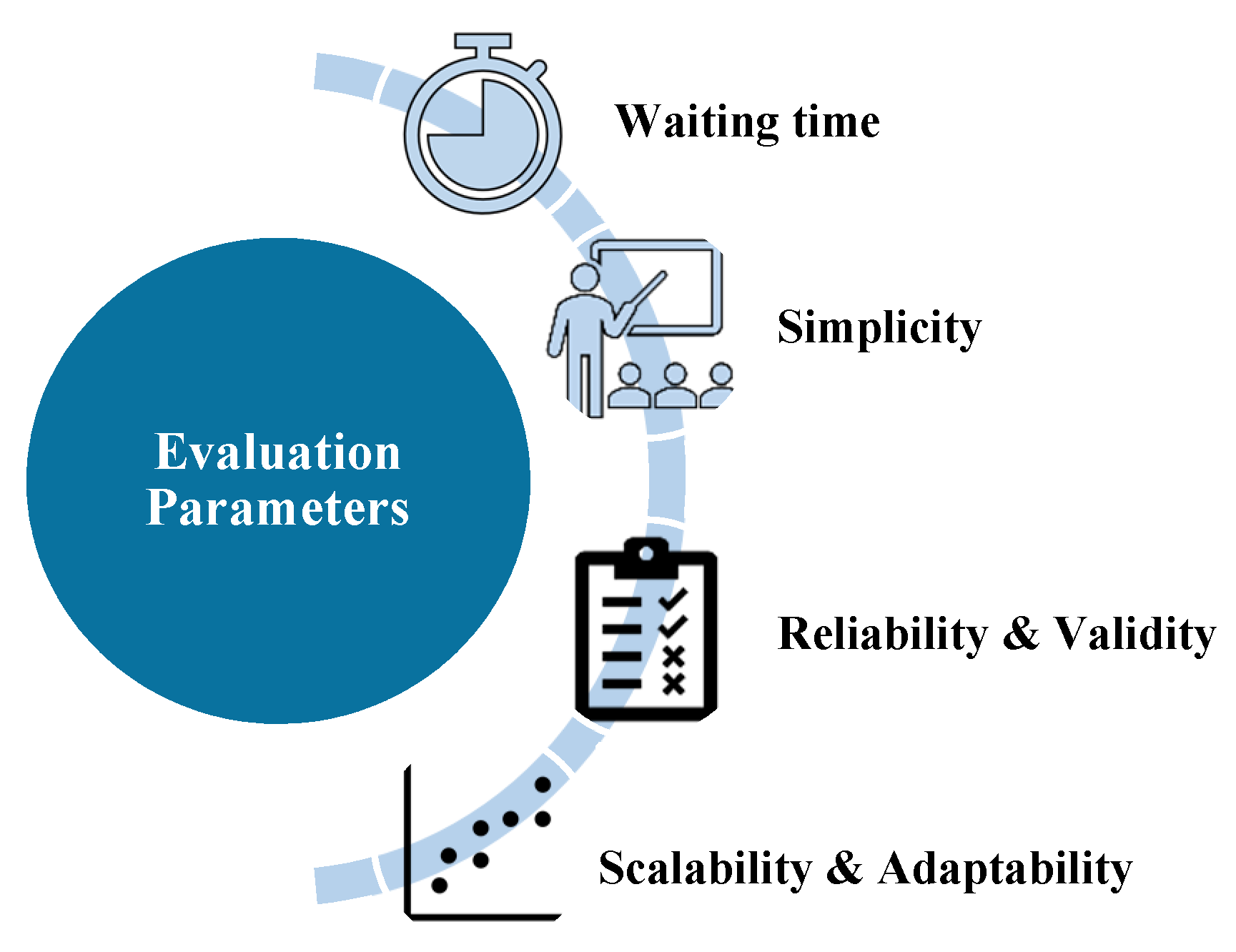
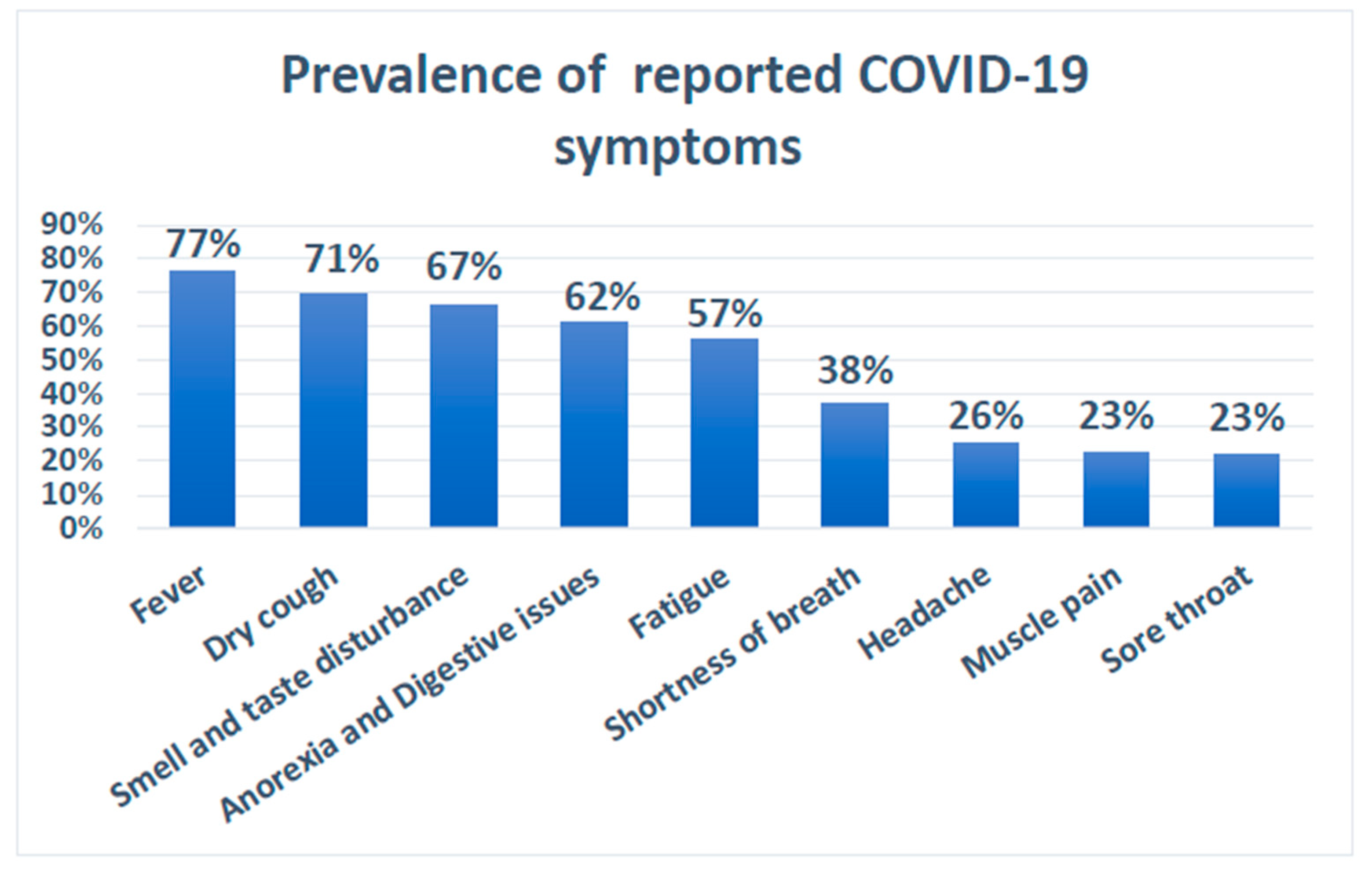

| Triage System | Categories or Triage Levels ↓ | Waiting Time (In Minutes) | Published Year | Ref. | Remark |
|---|---|---|---|---|---|
| Australasian Triage Scale (ATS) | Resuscitation Emergency Urgent Semi-urgent Non-urgent | 0 10 30 60 120 | 1993 | [36,37] | - |
| Manchester UK (MTS) | Immediate Very urgent Urgent Standard Non-urgent | 0 10 60 120 240 | 1994 | [38] | - |
| Canadian Triage and Acuity Scale (CTAS) | Resuscitation Emergent Urgent Less urgent Non-urgent | 0 15 30 60 120 | 1999 | [39,40] | It is updated every four years |
| South African Triage Scale (SATS) | Red Orange Yellow Blue Green | Immediate 10 60 120 240 | 2004 | [41] | - |
| France Clinical Emergency Department Classification (CCMU) | C1 C2 C3 C4 C5 CP CD CX | Not found | Not found | [8] | It classifies patients based on the severity of their case which impacts the required treatment resources |
| France Multi-centric Emergency Department Study Group (GEMSA) | G1 G2 G3 G4 G5 G6 GX | Not found | Not found | [8] | It refers to the patient’s affiliation after treatment in the ED (inpatient, discharged) and the mode of admission (planned or unplanned) |
| Saudi Ministry of Health (MOH) | Emergent Urgent Management | Not found | 2003 | [42] | There are several hospitals in Saudi Arabia adopting the CTAS system [43] |
| Approach # | Ref. | Aim | Improvement in | |||||||
|---|---|---|---|---|---|---|---|---|---|---|
| Categories or Triage Levels | Guidance for Each Level | Required Information to Classify the Patients | Procedure/Criteria to do the Classifications | Performer (Users) | Priority-Based on | Digital | Remotely | |||
| 1 | [9] | Enhancing the ED patient services and assist in resource allocating by forecasting daily attendance at an ED | 1. EP1 2. EP2 3. EP3 4. EP4 5. EP5 6. EP6 7. EP7 8. EPX | EP1 stable and discharged EP2 unstable and discharged EP3 stable and hospitalized. EP4 unstable and hospitalized EP5 moderate emergency accident but needs intervention EP6 critical condition need resuscitation EP7 dead before the entry EPX Others | The case severity & number of resources | GEMSA categories and the CCMU probability mass function | - | - | ✓ | ✗ |
| 2 | [44] | Telemonitoring system to classify and prioritize the patients | 1. Red (Risk) 2. Orange (Urgent) 3. Yellow (Sick) 4. Blue (Cold state) 5. Green (Normal) | 1. Direct the patient to the surgery room & its services 2. Direct the patient to the emergency room & its services 3. Direct the patient to the consultants’ section & its services 4. Send tips and messages | Sensors and text wireless body area network, 4 main ECG features related to various chronic heart diseases | Data fusion and fuzzy inference algorithms to estimate the priority | - | PC value and wait time | ✓ | ✓ |
| 3 | [45] | Improving the triage process by developing dynamic grouping and prioritization (DGP) algorithm | 1. Very Severe 2. High Severity 3. Relatively High Severity 4. Medium Severity 5. Relatively Low Severity 6. Very Low Severity | The patient goes to the waiting room, or the pediatric ER if the age under 18 years old | Gender, age, pain level, expected treatment time, and vital signs | Patients are categorized into eight types based on their priority, age, and group | Health care provider (The greeter’s desk collects the patient info and complaint, then pass it to a triage nurse) | FCFS (Unless the patient’s condition requires immediate care) | ✓ | ✗ |
| 4 | [46] | Prioritize and schedule patient visits. Also, reduce the average waiting time | 1. Emergency 2. Urgent 3. Referral 4. Normal | - | Patient health and vital status | Patient’s health and vital condition | Physician | The type and duration of service required | ✓ | ✗ |
| 5 | [50] | Reducing the median waiting time outside the triage area to less than 30 min | 1. Fast Track 2. Red 3. Yellow 4. Green | 1. Treatment area (TA) 2. Registration → TA 3. Registration → Emergency queue → TA 4. Treatment given in triage à Discharge home | - | - | Doctors & nurses | Risk level | ✗ | ✗ |
| 6 | [51] | Reducing waiting time for high-priority patients | 1. Resuscitation 2. Emergent 3. Urgent 4. Non-emergency | 1. Primary trauma care 2. Critical care 3. Secondary care 4. Non-primary care | levels of acuity | 1. primary trauma care 2. critical care cases 3. non-critical and secondary care 4. non-primary care | Chief physician | FCFS | - | ✗ |
| 7 | [47] | Improving the system by managing waiting time | - | - | Vital signs | Level of risk of the patient’s condition | Triage nurse | Risk level | ✓ | ✗ |
| 8 | [49] | Improving triage systems (CTAS) | - | Patients wait either in the waiting room or on a stretcher chair if the triage nurse deems it necessary | Determine the most appropriate CCD from a list of 474 possible conditions | - | Triage nurse, patient selection decisions are made by the Chief Nurse or ED official | FCFS | - | ✗ |
| 9 | [52] | COVID--19 pandemic triage algorithm for EDs | 1. Red (Need Resuscitation) 2. Pink (Toxic) 3. Blue (Needs workup) 4. Yellow (Needs minimal workup) 5. Green (Does not need workup) | - Admitted to intensive care (1, 2, and 3) - Admitted to Acute care (1, 2, and 3) - Discharge home (4 and 5) | clinical features, and it is vital | Droplet: distance >6 feet (greens, some yellows) Contact + droplet: distance Airborne: invasive procedures expected (red) | - | Reduction in patient volumes | ✓ | ✓ |
| No. | Symptoms | Description | Criteria | Percentage [69] | Percentage Others |
|---|---|---|---|---|---|
| 1 | Fatigue | Feeling of tiredness and an overall lack of energy | Feeling weak or sluggish. | 68% | 44–70% [70,72,73,74,76] |
| 2 | Smell and taste disturbance | Troubles with the normal capabilities of smelling and tasting. | “Cannot smell or taste anything, or things smell or taste different to normal” [77] | 64% | 58.6–75% [78,79,80,81] |
| 3 | Dry cough | A cough that does not produce mucus. | Strong cough lasting more than an hour, or they have such incidents for three or more times in a day [77] | 60% | 59–82% [70,72,73,74,76] |
| 4 | Fever | High temperature | Temperature is 38 °C or over | 55% | 83–99% [70,72,73,74,76] |
| 5 | Muscle pain | Soreness and achiness in the muscles | Mild to severe | 44% | 11–35% [72,73,74] |
| 6 | Headache | A painful sensation in any part of the head | Ranging from sharp to dull | 42% | <10% [72,73,74] |
| 7 | Shortness of breath | Breathing difficulties | Suffering from suffocation or being unable to take a breath | 41% | 31–44% [70,71,72,73,74,76] |
| 8 | Sore throat | The raw, scratchy, burning feeling at the back of throat | Trouble breathing or swallowing | 31% | 14% [76] |
| 9 | Anorexia and Digestive issues | Eating disorder | Lack of appetite, diarrhea, vomiting, or abdominal pain | NA | 40–84% [70,71,72,74,75] |
| No. | Type | Criteria [66,76] | Criteria [68,84,85] | Guidance |
|---|---|---|---|---|
| 1 | Mild | Patient with unsophisticated upper respiratory tract viral infection and possibly having general symptoms such as fever, fatigue, and cough. |
| Isolation and monitoring in the hospital, in some cases home isolation is sufficient [85] |
| 2 | Moderate |
| Fever, respiratory symptoms, and imaging findings of pneumonia | Not found |
| 3 | Severe | Patients with the followings:
| Patients with any of the following:
| Not found |
| 4 | Critical | Acute respiratory distress syndrome (ARDS)
| Patients with any of the following:
| Not found |
| No. | Type | Criteria [68] | Guidance |
|---|---|---|---|
| 1 | Suspected Case | Having two or more of:
| Not found |
| 2 | Confirmed Case | Any of the following etiological signs:
| Not found |
| No. | Type | Criteria [61] | Guidance [61] |
|---|---|---|---|
| 1 | ESI 1 |
| Direct to Cardiopulmonary Resuscitation (CPR) room |
| 2 | ESI 2 |
| Supplemental oxygen treatment (Severe pneumonia) |
| 3 | ESI 3 |
| Direct to an isolated waiting room |
| 4 | ESI 4 |
| Home care, directing the patient to other clinics, providing supportive/symptomatic treatment |
| 5 | ESI 5 | There has been no visit to an infected area in the last 14 days, no contact with an infected person, and no display of symptoms. | Direct to other health clinics or home care |
| No. | Type | Criteria [62] | Guidance [62] |
|---|---|---|---|
| 1 | High risk |
| Direct to the COVID-19 fever clinic |
| 2 | Medium risk |
| Direct to the COVID-19 fever clinic |
| 3 | Low risk |
| Direct to the COVID-19 fever clinic |
| 4 | No risk |
| Direct to the general fever clinic. Monitor if the fever lasts for more than 3 days and consult a doctor |
| Ref. | Type | Department | Objective | Classification Levels | Type of Criteria |
|---|---|---|---|---|---|
| [54,55] | Plans and guidance | dermatology | protect against the spread of COVID-19 in the dermatology departments. | No levels | subjective |
| [56] | remote triage system | cancer | advice patients with neck and head cancer. | Two levels | Risk rate |
| [57] | guidance | electromyography | manage electromyography test requests during the COVID-19. | Three levels | subjective |
| [58] | guidance | heart disease | triaging heart disease patients during the COVID-19 pandemic. | subjective | |
| [59] | Resources assessment | ICU | Classifying patients with critical conditions at ICUs. | Two levels (low, high) | scores |
| [61] | guidance | General ED | enhance the ED’s triage system during COVID-19. | Five levels as Emergency Severity Index | subjective |
| [62] | questionnaire | Pediatric ED | early detection and controlling of children cases during COVID-19. | Three levels (High-risk, Medium-risk, Low-risk) | scores |
| [63] | admission criteria | Pediatric ED | determine the mechanism for admission and entry of COVID-19 sick children into health care facilities | Two levels (suspected, unsuspected) | subjective |
| [64] | Visual Triage Checklist | General ED | instructions and measures for Acute Respiratory Infection (COVID-19/MERS-CoV). | Two levels (respiratory pathway, None) | scores |
| [65] | Guidance and admission rules | ICU | Optimize the usage of medical resources at ICU during COVID-19. | Two levels (admitted, None) | subjective |
| No. | Input Symptoms Type | Input Symptoms | Criteria | Score | Format |
|---|---|---|---|---|---|
| 1 | Exposure Risk | 2 text questions | Any of the followings
| 2 | Binary (Y/N) |
| 1 | Clinical Signs and Symptoms | Fever | Fever > 38 | 4 | Binary (Y/N) |
| 2 | Cough (new or worsening) | Coughing as described in [77] | 4 | Binary (Y/N) | |
| 3 | Shortness of breath (new or worsening) | Suffocating, or unable to catch their breath | 4 | Binary (Y/N) | |
| 4 | Headache, sore throat, or rhinorrhea | Ranging from sharp to dull. Trouble breathing or swallowing | 1 | Binary (Y/N) | |
| 5 | Nausea, vomiting, and/or diarrhea | Lack of appetite, diarrhea, vomiting, or abdominal pain | 1 | Binary (Y/N) | |
| 6 | Chronic renal failure, Immunocompromised patient, CAD/heart failure | Existence of the disease | 1 | Binary (Y/N) |
| No. | Type | Criteria [68,84,85] | Possible Scores |
|---|---|---|---|
| 1 | Mild | 1. None of the below conditions: a. Fever b. Cough c. Respiratory 2. Any of the non-main symptoms (required) | 1–3 |
| 2 | Moderate | 1. One of the below conditions: a. Fever b. Cough c. Respiratory issues 2. Any of the non-main symptoms (Optional) | 4–7 |
| 3 | Severe | Scoring-based criteria: 1. Two of the below conditions: a. Fever b. Cough c. Respiratory issues 2. Any of the non-main symptoms (Optional) None Scoring-based criteria: 1. Any of the below conditions: a. “Respiratory rate > 30 breaths/min” b. Severe respiratory suffering c. “SpO2 < 90% on room air “ | 8–11 |
| 4 | Critical | Scoring-based criteria: 1. Having fever, cough, and respiratory symptoms 2. Any of the non-main symptoms (Optional) None Scoring-based criteria: 1. Any of the below conditions: a. “Respiratory failure, need mechanical assistance” b. “Shock” c. “Organ failure” where ICU is a must. | ≥12 |
| Type | Feature | Description and Format | Selected Status |
|---|---|---|---|
| General Info. | Case Id | Identification Number | |
| Age | Patient’s age as an integer | ||
| Clinical Signs and Symptoms | Fever | Yes/No recorded as Integer (1 or 2) | ✓ |
| Shortage of Breath | Yes/No recorded as Integer (1 or 2) | ✓ | |
| Cough | Yes/No recorded as Integer (1 or 2) | ✓ | |
| Chronic—Diabetes | Yes/No recorded as Integer (1 or 2) | × | |
| Chronic—Hypertension | Yes/No recorded as Integer (1 or 2) | ✓ | |
| Chronic—Cardiovascular | Yes/No recorded as Integer (1 or 2) | ✓ | |
| Chronic—Dyslipidemia | Yes/No recorded as Integer (1 or 2) | × | |
| Chronic—kidney disease | Yes/No recorded as Integer (1 or 2) | × |
| Target | Main Symptoms | Others | # Samples | |||
|---|---|---|---|---|---|---|
| Fever | Shortage of Breath | Cough | Hypertension | Cardiovascular | ||
| Group 1 (count and %) | 22 | 30 | 21 | 17 | 8 | 43 |
| 51% | 70% | 49% | 40% | 19% | ||
| Group 2 (count and %) | 118 | 87 | 117 | 38 | 10 | 134 |
| 88% | 65% | 87% | 28% | 7% | ||
| Information | Group 2 of the Dataset (134 Samples Where Target = 2) | |
|---|---|---|
| Severity Level | Severe Level | Critical Level |
| Criterion | Two of the main symptoms | All the three main symptoms |
| # samples | 80 | 54 |
| ration | 60% | 40% |
| Scoring Range | 8–11 | ≥12 |
Publisher’s Note: MDPI stays neutral with regard to jurisdictional claims in published maps and institutional affiliations. |
© 2021 by the authors. Licensee MDPI, Basel, Switzerland. This article is an open access article distributed under the terms and conditions of the Creative Commons Attribution (CC BY) license (https://creativecommons.org/licenses/by/4.0/).
Share and Cite
Alhaidari, F.; Almuhaideb, A.; Alsunaidi, S.; Ibrahim, N.; Aslam, N.; Khan, I.U.; Shaikh, F.; Alshahrani, M.; Alharthi, H.; Alsenbel, Y.; et al. E-Triage Systems for COVID-19 Outbreak: Review and Recommendations. Sensors 2021, 21, 2845. https://doi.org/10.3390/s21082845
Alhaidari F, Almuhaideb A, Alsunaidi S, Ibrahim N, Aslam N, Khan IU, Shaikh F, Alshahrani M, Alharthi H, Alsenbel Y, et al. E-Triage Systems for COVID-19 Outbreak: Review and Recommendations. Sensors. 2021; 21(8):2845. https://doi.org/10.3390/s21082845
Chicago/Turabian StyleAlhaidari, Fahd, Abdullah Almuhaideb, Shikah Alsunaidi, Nehad Ibrahim, Nida Aslam, Irfan Ullah Khan, Fatema Shaikh, Mohammed Alshahrani, Hajar Alharthi, Yasmine Alsenbel, and et al. 2021. "E-Triage Systems for COVID-19 Outbreak: Review and Recommendations" Sensors 21, no. 8: 2845. https://doi.org/10.3390/s21082845
APA StyleAlhaidari, F., Almuhaideb, A., Alsunaidi, S., Ibrahim, N., Aslam, N., Khan, I. U., Shaikh, F., Alshahrani, M., Alharthi, H., Alsenbel, Y., & Alalharith, D. (2021). E-Triage Systems for COVID-19 Outbreak: Review and Recommendations. Sensors, 21(8), 2845. https://doi.org/10.3390/s21082845










